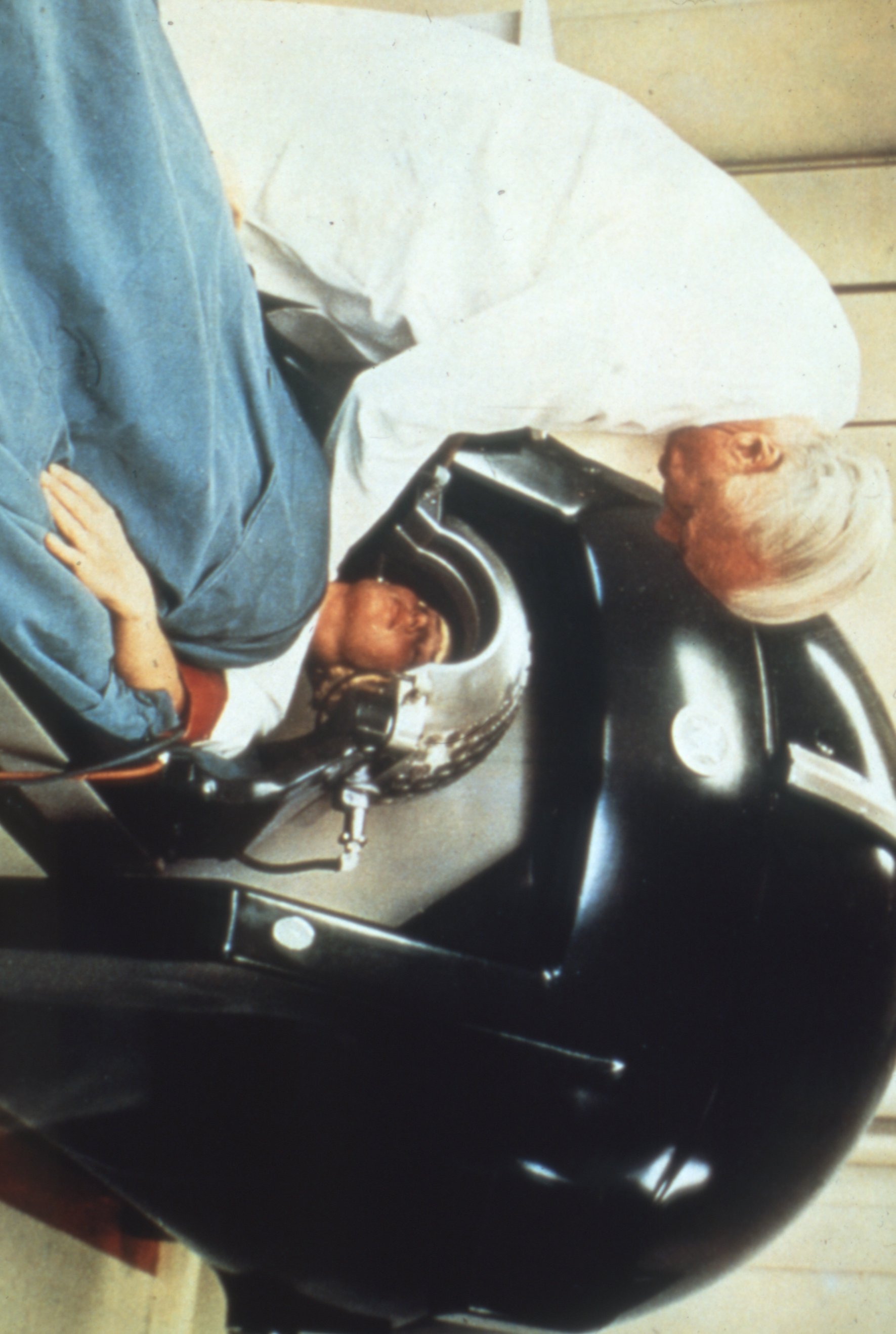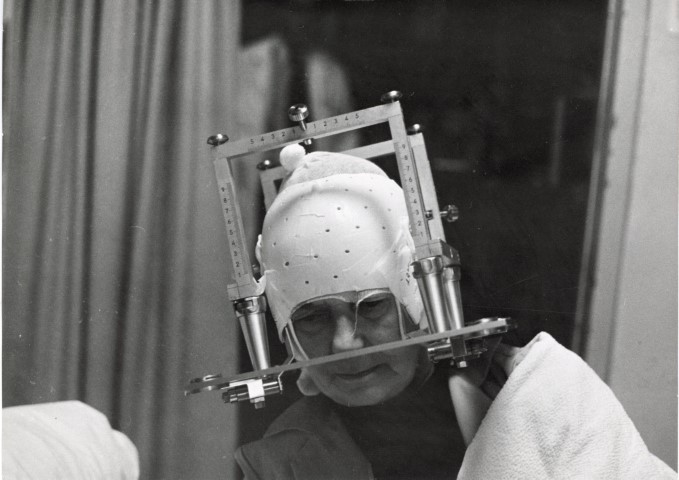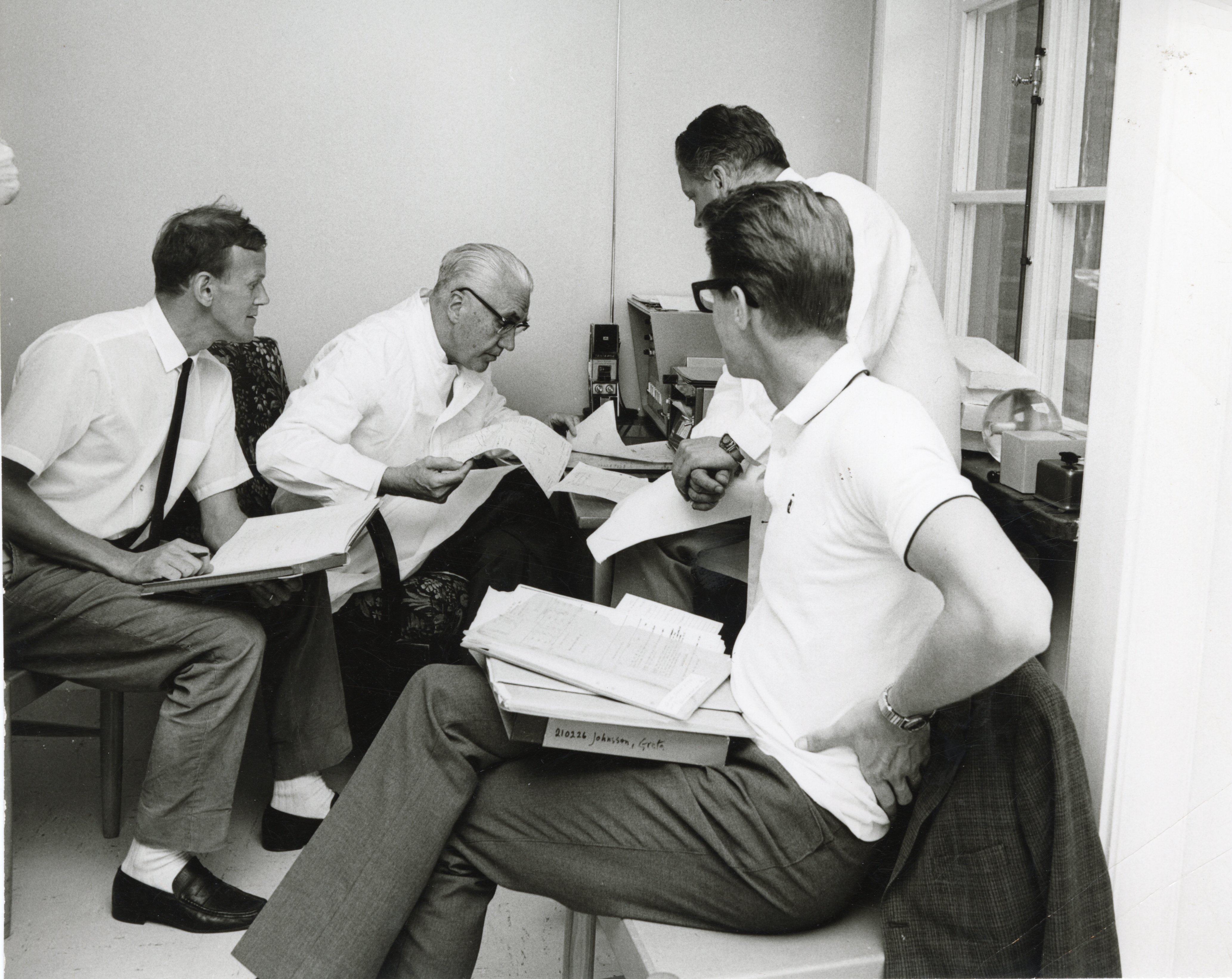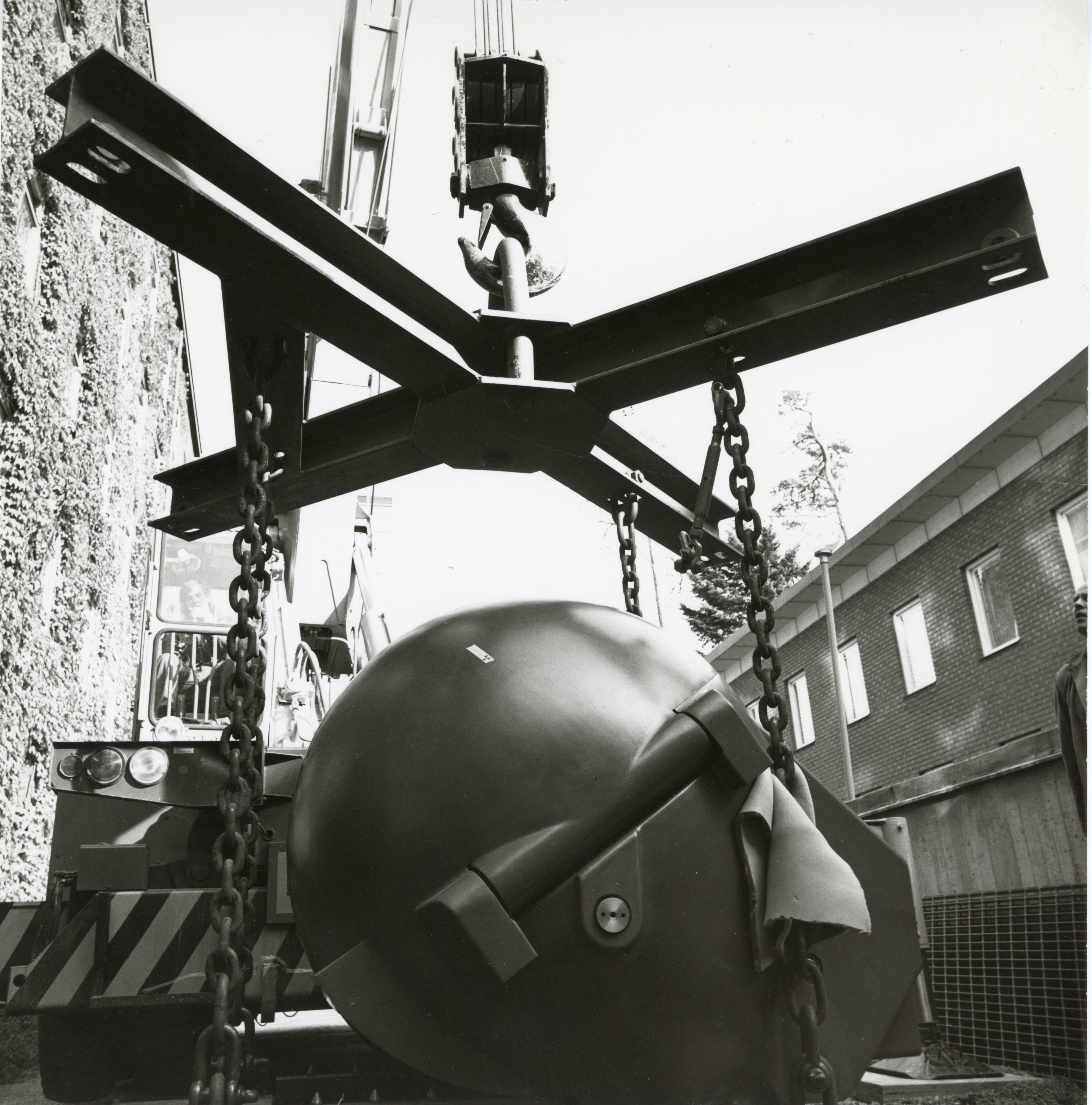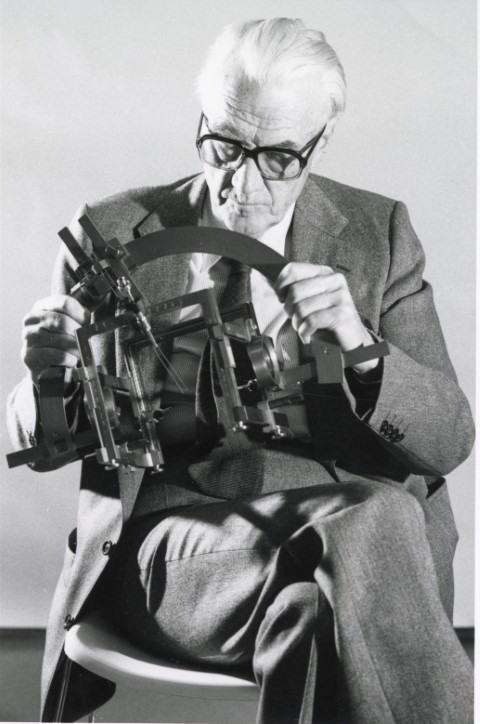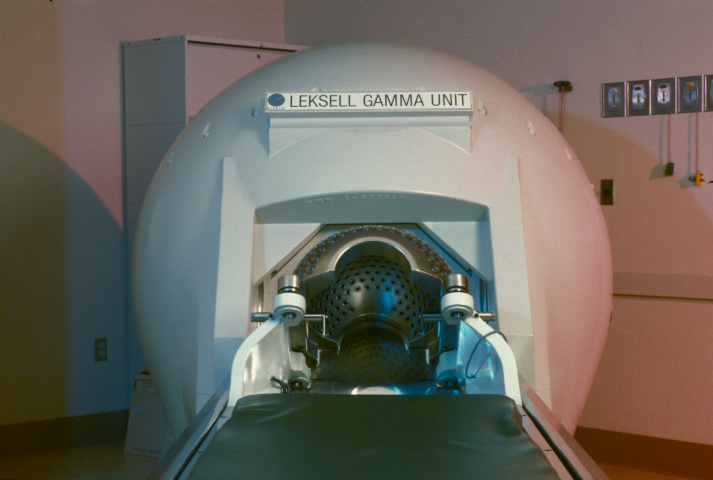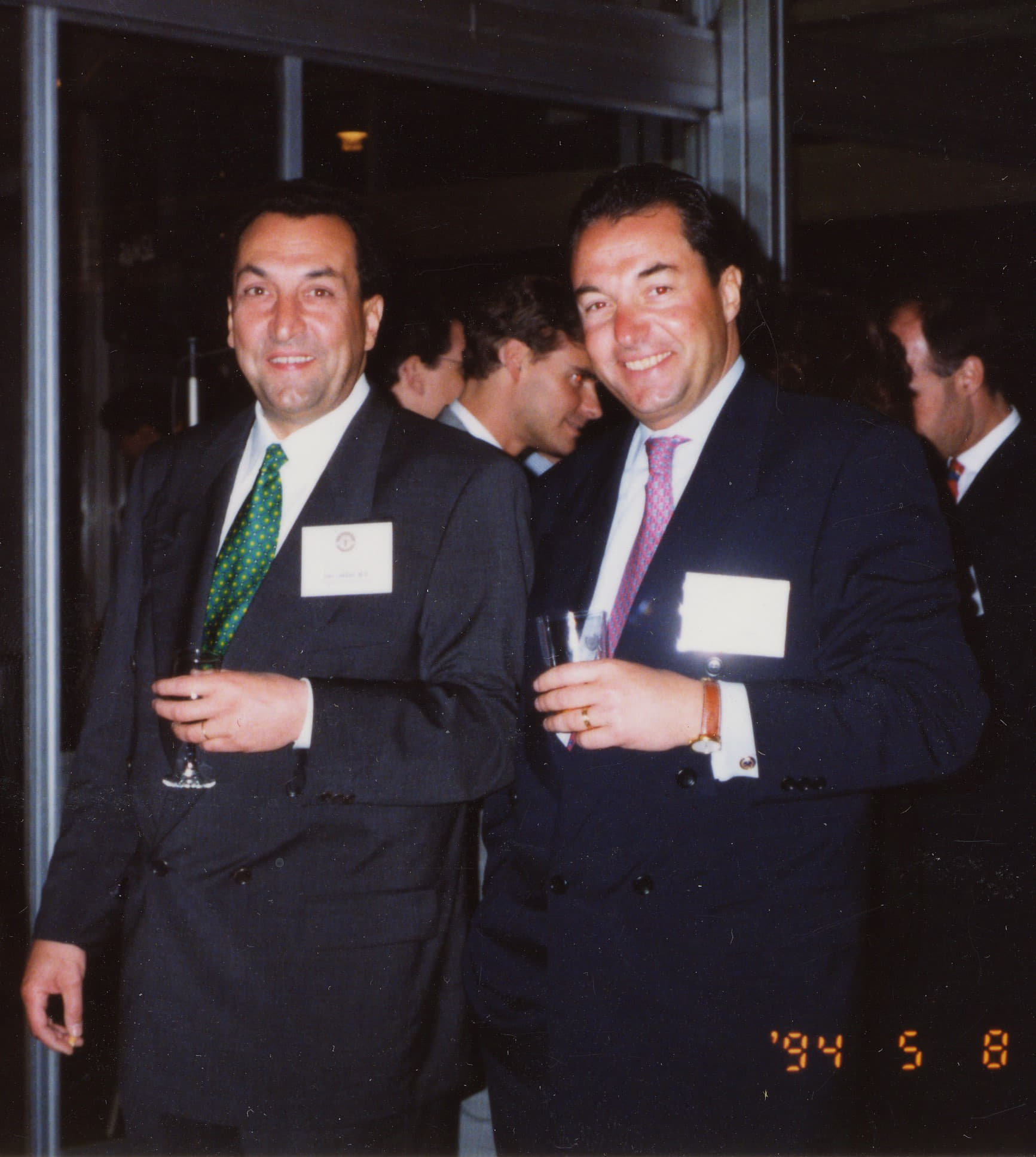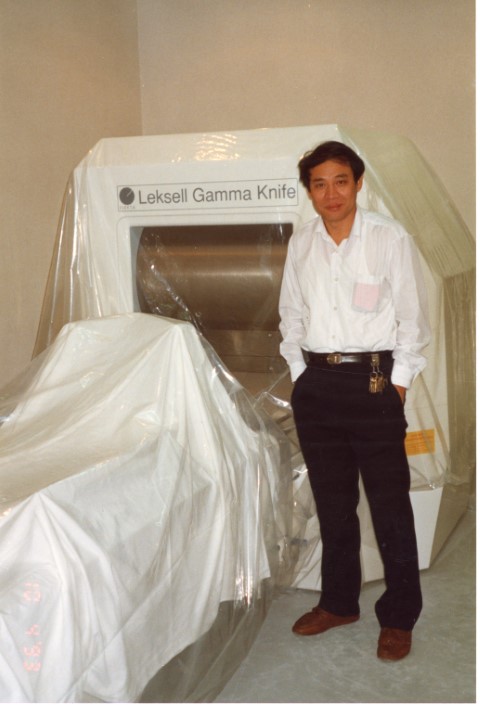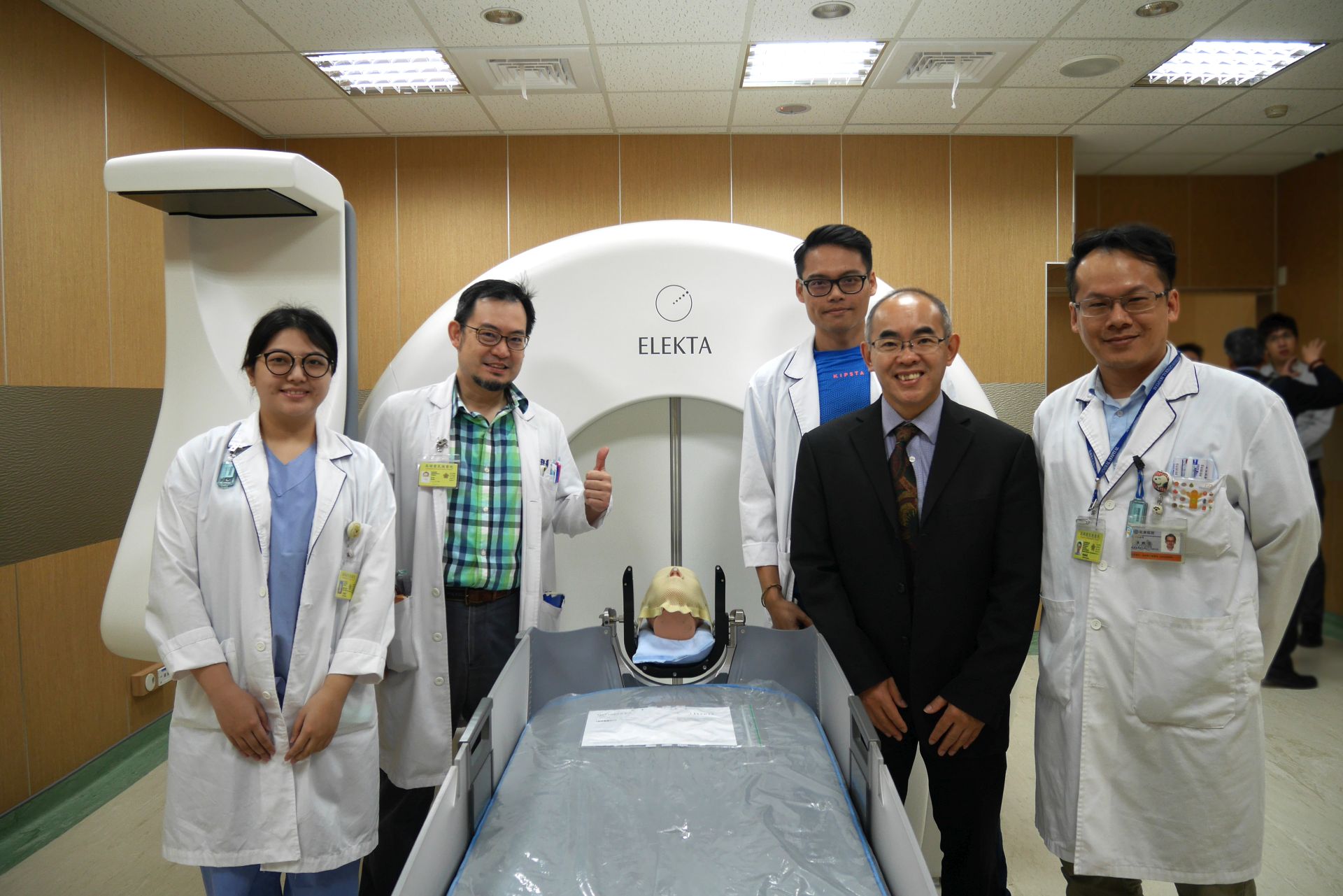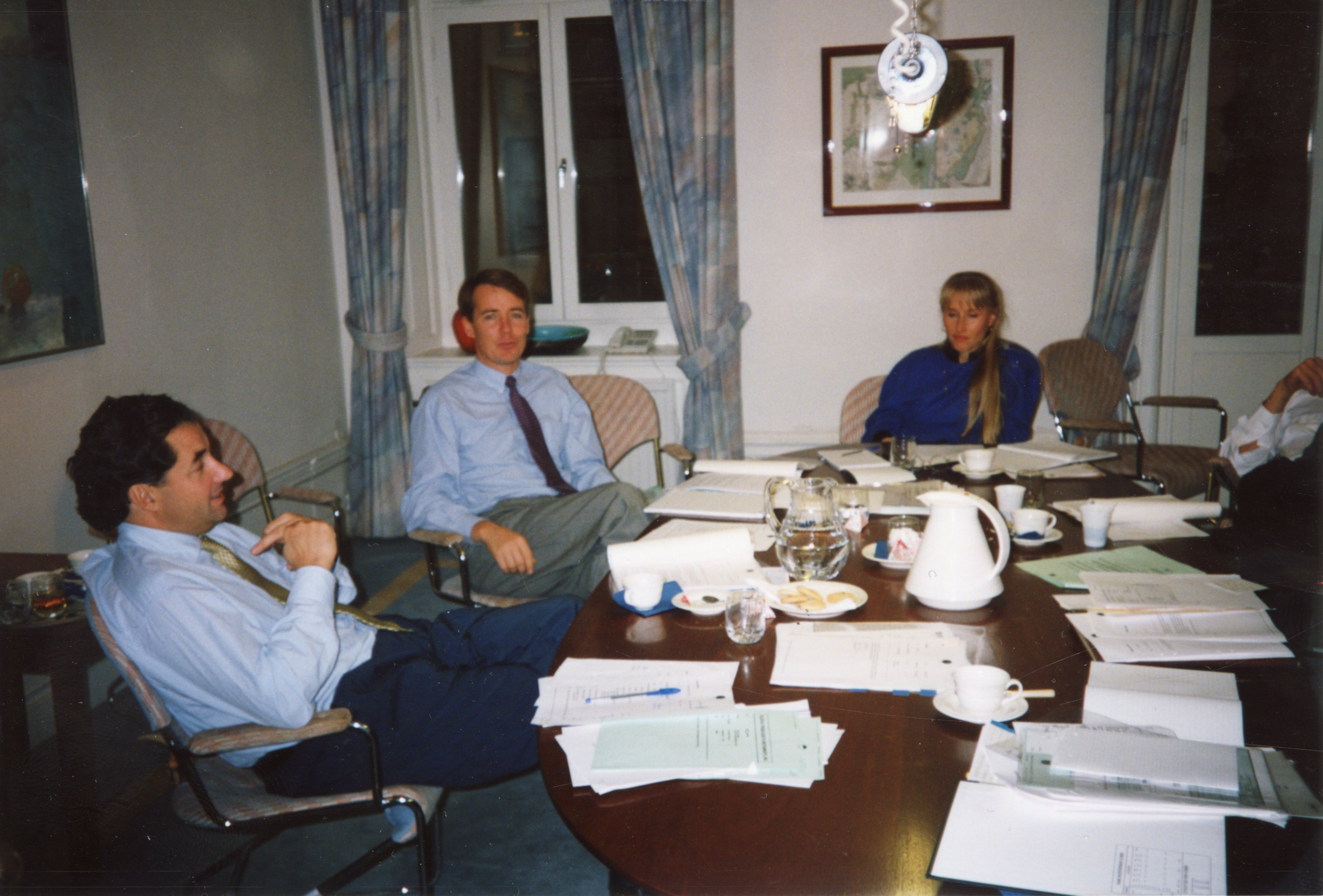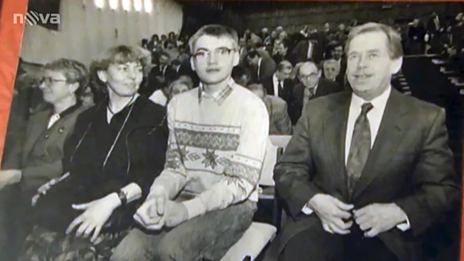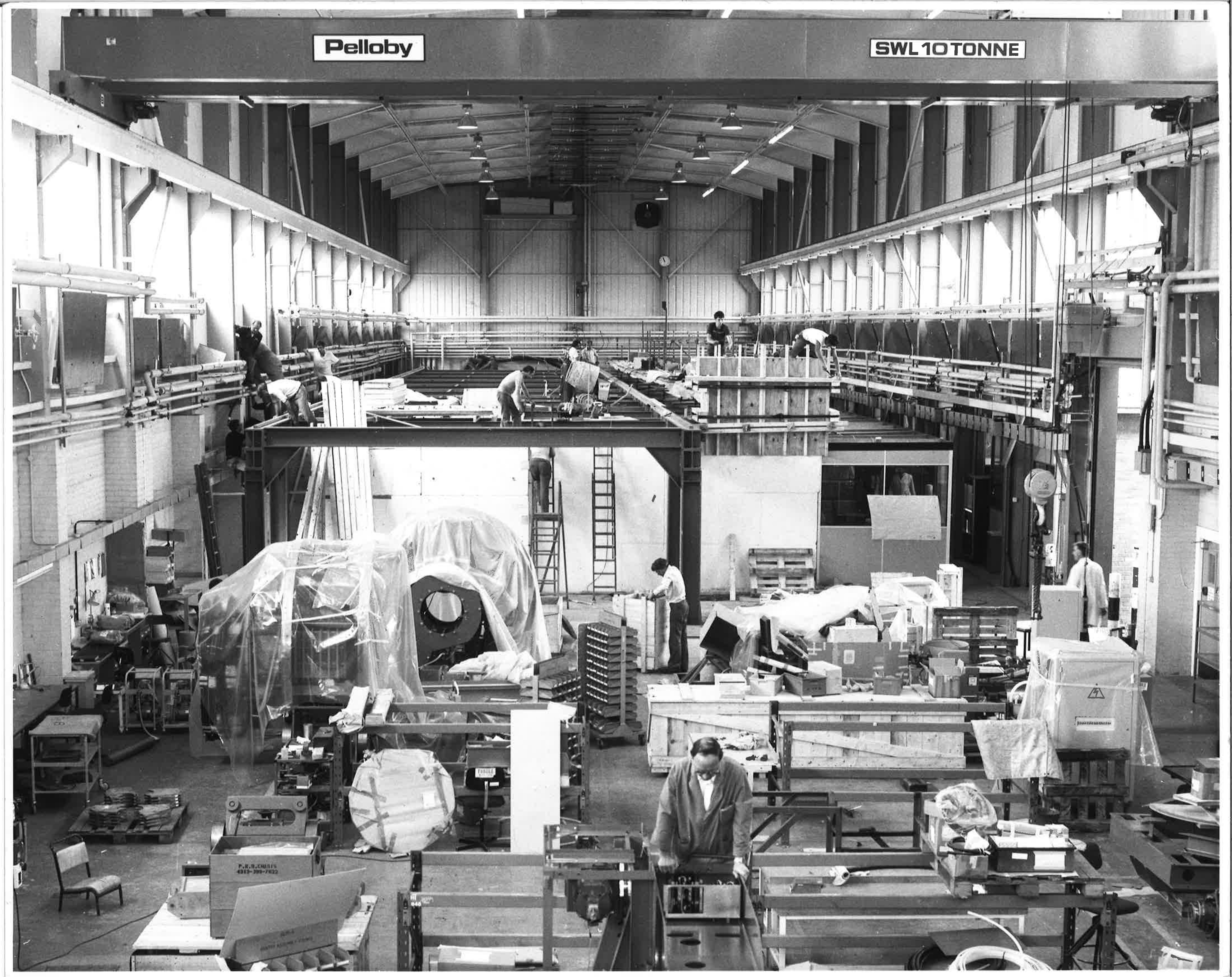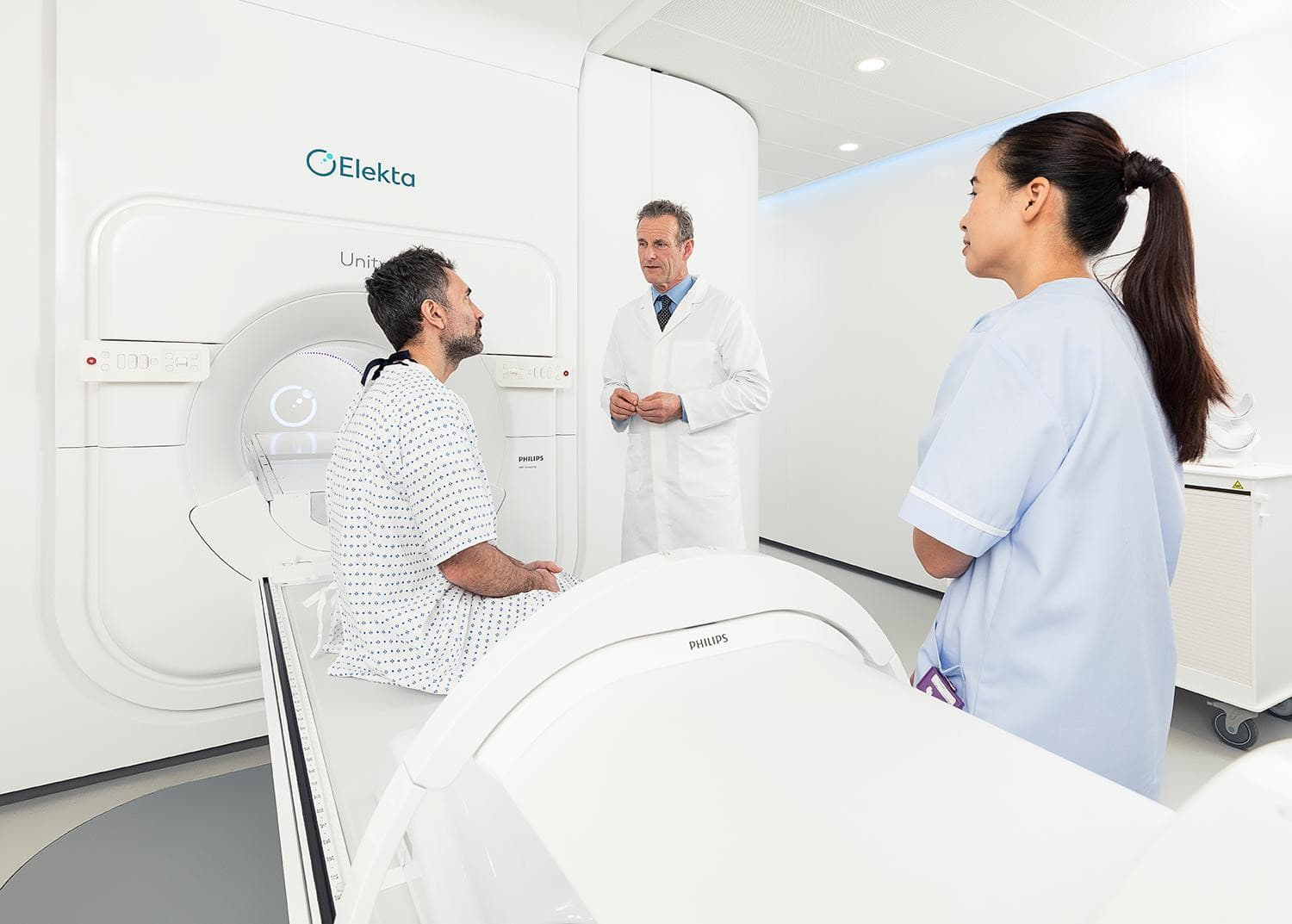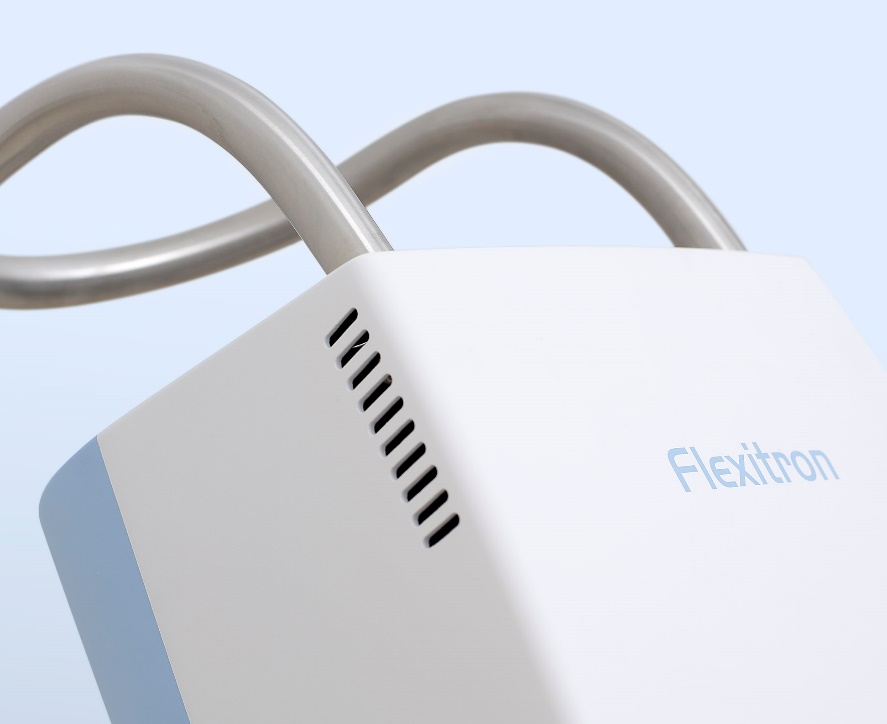A Company Grows Up
1986-1993
Reading time: 5 minutes
Finally, the first Gamma Knife sale! The treatment brings new hope to cancer patients, while Elekta figures out how to work with health care providers worldwide. And for ways to treat more than just the brain. Can the Elekta way be used for the whole body?

Professor Lars Leksell did not found Elekta, nor was he actively engaged in its management. It was his son Laurent (Larry) who created the company for him, primarily for practical fiscal reasons. And it was Larry and his brother Dan (Danny), together with a few others, that kept the operations running for over a decade, while developing careers of their own elsewhere. Still, Elekta’s credibility remained centered on Professor Leksell’s reputation as a prominent surgeon and, not least, his vision of a new, noninvasive kind of neurosurgery.
So his death in January 1986 naturally left the small company shaking to its foundations.
The company had actually never sold any Gamma Knife systems under its own name. It wouldn’t have surprised anyone if Elekta had sold itself to some other company with more financial muscle. In fact, it wouldn’t have caused much disbelief if Elekta had ceased activities altogether.
Instead, after his father’s death, Larry Leksell decided to dedicate himself fulltime to Elekta.
Since incorporating Elekta in 1972, Larry had combined his engagement in Elekta with an academic career in business economy. He had held posts at the University of Hawaii, Harvard Business School in Boston, INSEAD in Paris and the Stockholm School of Economics, where he defended his doctoral thesis in 1979. In 1982, he had left academia to start the consultant firm Nordic Management, which quickly became successful and worked internationally. During this time, Elekta remained a side venture for Larry, one that made some profit selling licenses for the Leksell Stereotactic Instrument, while trying to create a market for radiosurgery with Gamma Knife.
The death of Professor Leksell in 1986 drove Larry’s decision to leave the flourishing Nordic Management and direct all of his attention to the company founded around his father’s innovations and legacy. He wouldn’t dissolve the company, he would develop it.
“If Larry hadn’t stepped in full time in 1986, Elekta would not be around today. It’s as simple as that.”
Tomas Puusepp joined Elekta in 1988 and would over time become a key collaborator and later the company’s second CEO after Larry. He commented: “If Larry hadn’t stepped in full time in 1986, Elekta would not be around today. It’s as simple as that. He left a company which was running at full speed to work for an almost bankrupt company. Many thought he was totally crazy.”
The importance of Pittsburgh
In the mid-1980s, stereotactic radiosurgery (SRS) via Leksell Gamma Knife was a method used in Stockholm, Buenos Aires and Sheffield. It had not, however, really entered the conscious awareness of the field of neurological surgery. The discipline was hard at work considering other options to traditional neurosurgery, experimenting with cyclotron-generated particle beams, or linear accelerators converted to highly focused, single session radiosurgery. The professional organizations in the fields of neurosurgery and radiation oncology were either uninterested or openly critical of Gamma Knife. The new invention seemed to clash with established structures and thought patterns. Neurosurgeons didn’t like the fact that their primary skillsets as surgeons could potentially be replaced by a machine. And radiation oncologists didn’t like neurosurgeons entering their domain of radiation-based treatments.
Breaking such time-honored barriers takes time, but sometimes a successful precursor can speed up the process. And for that, a champion for the cause is helpful.
Dade Lunsford, Lars Leksell’s friend and former pupil, had returned to the United States from his stay at Stockholm’s Karolinska Hospital in 1981. He had joined the Department of Neurological Surgery at the University of Pittsburgh and held a post as neurosurgeon at the Presbyterian University Hospital (UPMC). He introduced Lars Leksell’s ideas about stereotactic radiosurgery to the US neurosurgical community, initially receiving little enthusiasm. He started, however, to gain traction with his own hospital by signing a deal with the unknown Swedish company for a Gamma Knife system.
If Elekta managed to install the knife, it would be the first Gamma Unit in clinical use in America. Of course, such a process spanned several years. Professor Leksell, who was still alive when the deal started to take form (but didn’t live to see its conclusion), had been excited about the possibility. His son Larry had been more hesitant, seeing a number of complicating factors.
First, since Presbyterian Hospital wouldn’t pay for the deal in advance, the project required considerable advance funding, money that Elekta simply didn’t have at the time. Second, now that the cooperation had broken down with Scanditronix, which had been the official installing partner for the Buenos Aires and Sheffield Gamma Knife units, there was no designated producer that could actually manufacture Gamma Knife, and the original drawings were still with Scanditronix’s subsidiary company, Nucletec, in Switzerland. Third, introducing the new procedure and technology for clinical use in the US would require the approval of American authorities—not a simple thing.
For funding, Larry Leksell approached Investeringsbanken, an investment bank operated by the Swedish state. Its CEO at the time, Harry Schein, was a central and well-known figure in the Swedish power elite. Schein had a background as a chemical engineer, and he was quite interested in new technological solutions. He also had been an old friend of Lars Leksell and was familiar with his ideas about new neurosurgical solutions. With Schein’s support, Larry Leksell managed to get the necessary financial guaranties from Investeringsbanken. With this, Presbyterian Hospital felt safe to go through with the deal.
In parallel, Larry Leksell negotiated with Scanditronix leader Curt Mileikowsky and managed to regain the production and sales licenses for Gamma Knife. Finding a new manufacturer was an entirely different matter. Eventually, Elekta returned to Motala Verkstad, the workshop that had produced the first two Gamma Knife machines. Motala Verkstad was suffering from financial problems, but it still had the skill and equipment to do the job.
The development of the initial prototype Gamma Knife, though, was now twenty years in the past and to revive production would take some effort. And this time, learning from the Scanditronix experience, Elekta wanted to control and coordinate the technical work of its subcontractor.
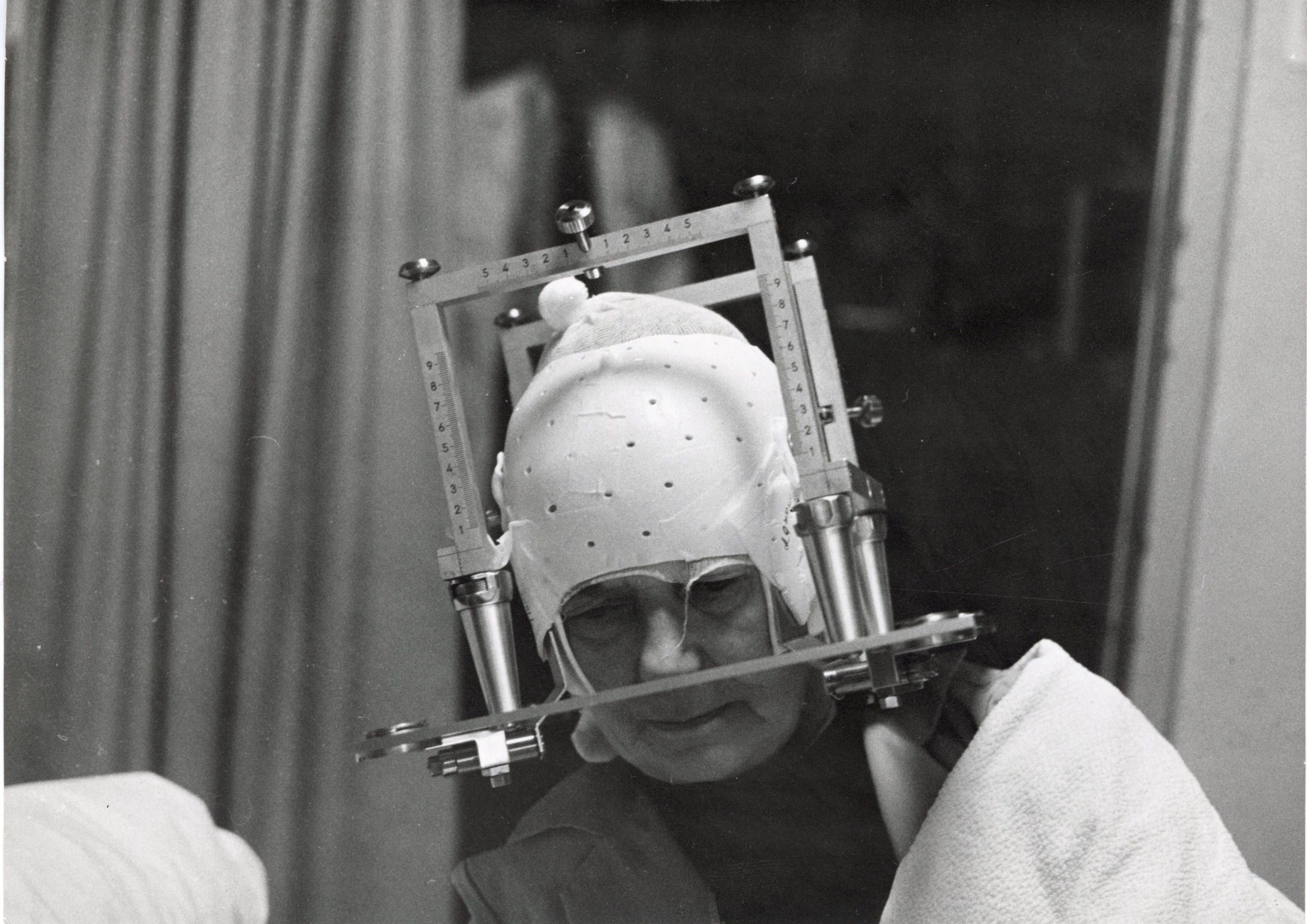

The engineer Hans Sundquist, who had been crucial during the creation of the Gamma Knife prototype in 1967, was by now employed elsewhere. Leksell approached him and offered him the job as a chief engineer at Elekta: “We are going to build a Gamma Knife, you see.”
Sundquist accepted the offer and went searching for early designs of the prototype in an attic at Motala Verkstad. From what he found, he developed new drawings to replace the ones still in Nucletec’s possession in Switzerland. A development office was established, divided between Linköping and Stockholm and six people were hired.
This left the issue of obtaining US authority permits for medical equipment. Here, luck came to the rescue. Because although the Pittsburgh Gamma Knife would be the first in the US for clinical purposes, another Gamma Knife had already been in the country for five years!
It was the very first prototype Gamma Unit, the one that had been in use at the Sophiahemmet Hospital in Stockholm and had become obsolete when the Karolinska Hospital acquired the second unit in 1974. Professor Robert Rand at the University of California in Los Angeles (UCLA)—yet another old professional acquaintance of Lars Leksell—had bought that Gamma Knife system, for the symbolic sum of one dollar, for experimental purposes. The equipment had been shipped and discretely entered into the US. Since it was not intended for clinical use on humans, the necessary permissions were granted, and in 1981, the unit was installed without too much administrative difficulty.
Consequently, when the US Food and Drug Administration (FDA) in 1986 assessed the Pittsburgh installation, they had a precedent to help facilitate the process. And just like that, the prototype Gamma Knife from 1967 unexpectedly came to play a vital role for implementing the first “real” Gamma Knife deal in the US—twenty years later. (That Gamma Knife, nicknamed “the Ball”, remained in use in Los Angeles until 1992, when it was decommissioned by Hans Sundquist.)
From a technical point of view, the installation in Presbyterian Hospital in Pittsburgh went according to plan. And so, in August 1987, the first operation using the Pittsburgh Gamma Knife was carried out. Many more were to follow.
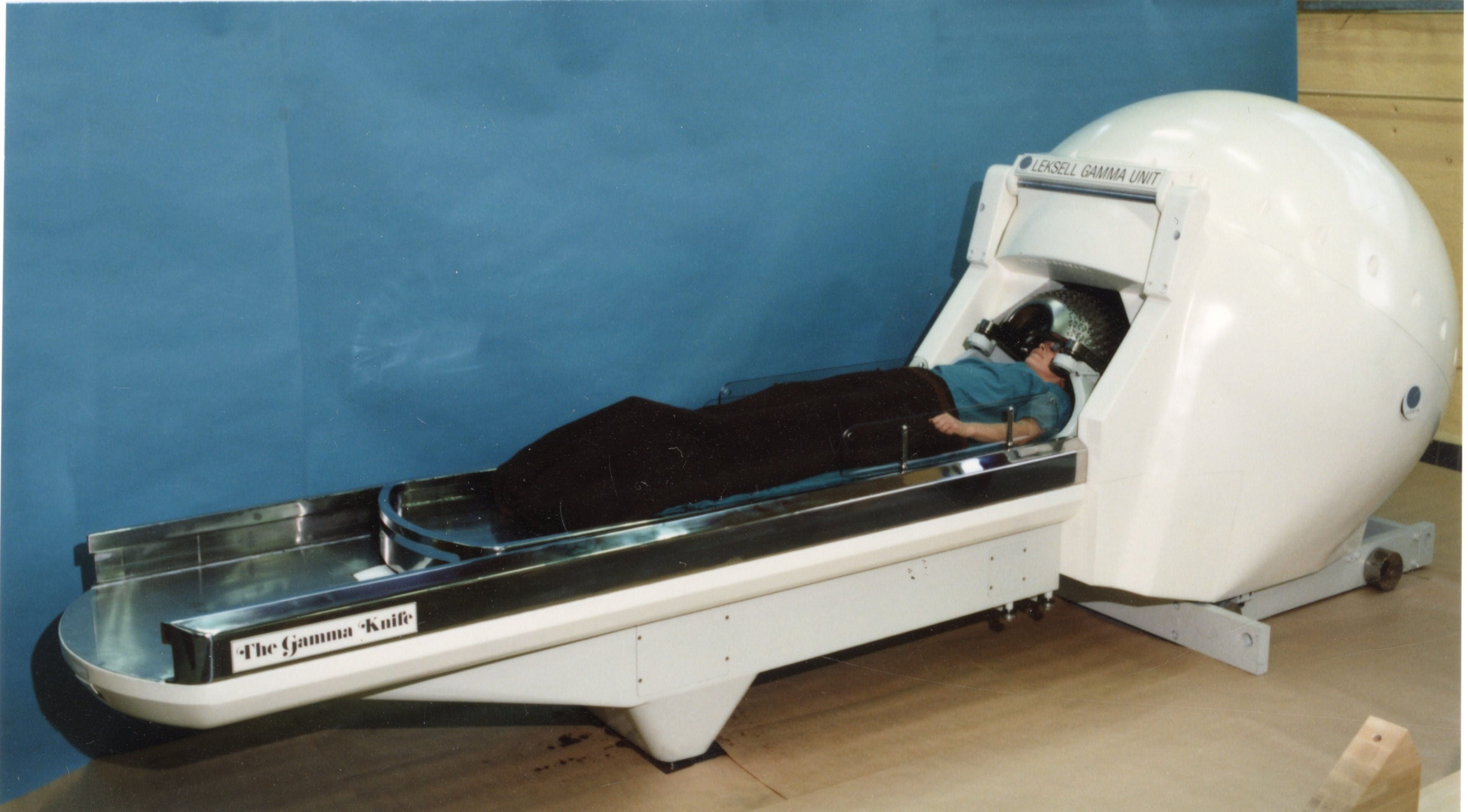
Pioneering years
Elekta’s first Gamma Knife sale to the US can hardly be overestimated. In one fell swoop, the company’s revenue increased from about two million SEK per year to 25 million SEK. More importantly, this was the first sale in Elekta’s own name, and it arrived in an important, high-competition market in which the technological solution and medical practice of stereotactic radiosurgery previously was practically unknown.
The Pittsburgh unit was hosted by a respected scientific and clinical milieu, and surgeons and researchers like Dade Lunsford and his colleagues began to produce scientific articles and papers in journals and at conferences, describing the results of the new method, comparing them with traditional neurosurgery and radiotherapy. In short order, a second Gamma Knife order was placed in the US, by Professor Neal Kassell at the University of Virginia, based on Lunsford’s recommendation. The word was spreading. Soon other hospitals and institutes, in the US and elsewhere, would follow suit.
The challenge now was to turn the success into something more than a one-hit wonder, to build an organization that could continue to commercialize and develop the company’s main products, the Leksell Stereotactic Instrument and Leksell Gamma Knife. While the stereotactic instrument showed a stable, steady growth in sales, Gamma Knife needed active and careful sales strategies. Each unit represented an investment of three to four million USD for each hospital. Such an endeavor naturally demanded careful consideration and trust.
To manage this, the company needed a dedicated, handpicked team of talented people. Larry Leksell himself knew the ins and outs of business and was a born entrepreneur. His brother Danny was a skilled physician, who could understand and communicate with doctors and surgeons who were the products’ potential users. Danny had decided early on to become a physician, but he had avoided following in his father’s footsteps to become a neurosurgeon. Instead, he became an MD specialized in ear, nose and throat (ENT) surgery. But like his brother Larry, he relinquished his academic career to work for the Elekta company. His role involved traveling the world, making presentations at congresses or giving lectures at hospitals, but also bestowing medical know-how on ways to further develop Gamma Knife and the Stereotactic Instrument.

But after the Pittsburgh deal, people with other skills and competencies were needed. One of the first was Larry Leksell’s university friend, Hans von Celsing, who was recruited as Deputy Executive Director. Another important recruitment was Tomas Puusepp, who came from Scanditronix. Puusepp was an experienced physicist, but also a talented salesman. When he started in 1988 as Sales Director he became employee number 21. Puusepp was responsible for the neurosurgery business outside the US (and was many years later to succeed Larry Leksell as CEO in 2005). Rolf Kjellström, today Vice President in charge of neuroscience sales and marketing. joined Elekta in 1989, together with Lena Höglund, who today is Chairman of Leksell Gamma Knife Society, and Göran Sommar, head of sales for the stereotactic instrument.
A sales office had already been established in the US in 1982, mainly to administer the sales of stereotactic frames. It was headed by John Rigby, who also represented a British med-tech firm, which until then had been distributing the stereotactic frame in the US. The company’s office was in Atlanta, and so Elekta Instruments Inc. was located in the same place. The office was reinforced in 1984 with Canadian Catherine Gilmore Lawless, who became a key associate for building up the American business and for sales internationally.
Gilmore Lawless had been on a university exchange in Stockholm when she first met Larry and his colleagues at Nordic Management, and had remained in Sweden after graduation, working first for Nordic Management and then full-time for Elekta. She later recalled: “I was in the right place at the right time because we were introducing a disruptive technology to a major market. It was paradigm shifting. Overcoming lots of objections and education was involved and I’d go to work with the best and brightest physicians in the world.”
An interesting aspect during this period was the common conviction among the team that the company was working for a cause that was more important than commercial success and profit. For several, including the Leksell brothers, this belief was founded on painful personal experiences of loss. Tomas Puusepp explains: “We all had relatives, family members, who had died of various diseases, and especially cancer. And here was a method with potential to take care of both cancer and vascular malformation and everything in the brain. We wanted to change how to treat people with serious illnesses. That was what really drove us all.”
Elekta was a growing company and this development did not remain unnoticed. In 1988, the Gamma Knife team was awarded the business journal Veckans Affärer’s prize “Guldkaggen” for outstanding innovation. By then, revenue had grown to 83 million SEK and the number of scientific publications from neurosurgeons using Gamma Knife also increased year on year, creating momentum for new deals. The Stockholm office was no longer a single room in Lars Leksell’s apartment on Strandvägen, or in Nordic Management’s office on Linnégatan. Elekta now had its own premises, on Skeppargatan 8, and space was filling up quickly.
Rolf Kjellström describes the atmosphere around 1990: “In those days, every time we sold a Gamma Knife was a big event. You rang a bell in the office and celebrated with champagne and cake. We didn’t sell more than five or six per year, so every Gamma Knife was significant.” The company now had about 25 employees, of which approximately 15 were located at the main office on Skeppargatan, and the others stationed in different parts of the world.
Heading for Asia
By the late 1980s, Elekta had established a foothold in North America, and had also had some results in Latin America following the Buenos Aires deal in 1983. In Europe, however, Gamma Knife technology was gaining little ground, save for Sweden and the United Kingdom, where the Sheffield unit was used successfully. Elekta had established sales offices in France and Switzerland, but business there was mainly about the Stereotactic Instrument, not Gamma Knife.
Instead, the company directed attention to more distant markets in Asia. After the US, Japan was the largest market in the world for medical equipment; to find a door to that market was the obvious next step. Such a door was provided by the Swedish trading company Mansson KK. This firm was established in the Japanese market since 1920 and had a well-developed network with contacts to hospitals all over the country. By mid-1980s, Larry Leksell had signed a deal with director Stig Sundberg, making Mansson KK the official Elekta representative in Japan.
Japanese neurosurgeons were informed about the new technology from conferences and from results published in the US. In addition, many Japanese patients had visited Stockholm to receive radiosurgical treatment at Karolinska Hospital. The treatment method was thus not entirely unknown in Japan when Professor Kintomo Takakura at the Tokyo University Hospital sent the first Japanese purchase request in 1988. Kintomo Takakura was the emperor’s personal physician and a highly respected neurosurgeon. Still, before any purchase could be made, the Japanese government would have to approve this new, foreign technology. And getting such an approval turned out to be difficult. Before a deal could be approved, a test round of 30 treatments had to be performed in Japan on Japanese citizens.
A successful installation in Japan had the potential to blow the Asian market wide open. Elekta did not hesitate to install a Gamma Knife in Tokyo on trial. Danny Leksell, physicist Jürgen Arndt and neurosurgeon Christer Lindquist were present in Tokyo to participate in the series of treatments. In August 1990, after two months of intensive preparations and treatments, the results were sent to the ministry for evaluation. Danny Leksell recalls: “I will never forget those two months. It was so satanically hot and humid, and it was raining all the time. Day and night. Monsoon period. But we wanted to be absolutely sure that they chose the right type of patient, treated with the right dose and so on. My hotel bill was expensive, but we received the permit, and Elekta could then continue to sell in Japan.”
With relief, Professor Takakura could summarize that no significant difficulties had occurred during the trials. Six months later came the official approval that Leksell Gamma Knife could be sold in Japan. The most expensive installation in the history of the company was over. As time would show, this was money well spent.
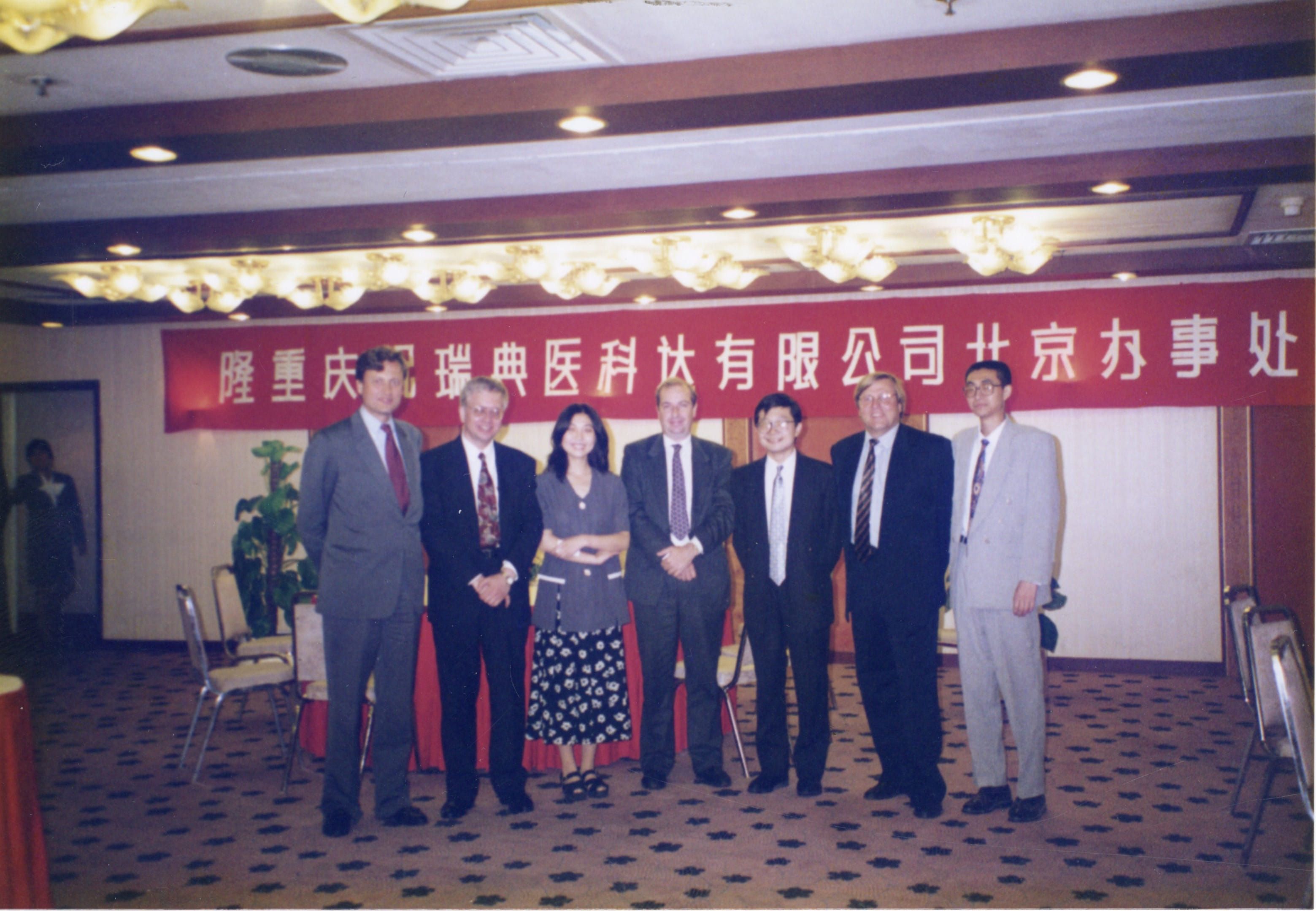
Several doctors from different hospitals had attended the 1990 clinical trials with great interest. During the next year no less than six new Gamma Knife systems were installed in Japanese hospitals, and by the end of 1995, five years after the government approval, a total of 14 units had been installed. On top of that, the Japanese market proved to be the key to South Korea, Taiwan and, as a final step, China. Elekta opened its Asian headquarters in Hong Kong in 1994. This office, initially lead by Rolf Kjellström, would coordinate all of the company’s activities in Asia except Japan. Asia quickly became one of Elekta’s most important market areas—and it still is.

The Gamma Knife Society
Despite the successes in various markets across the globe, radiosurgery was still in many parts considered with suspicion, or as an encroachment on traditional professional territories. Nevertheless, the number of neurosurgeons globally—who embraced the new technology and acted as informal advocates for Elekta—increased. To provide them with a forum for both professional exchange and social interaction, Danny Leksell in 1988 arranged a first, informal meeting in Bath, UK, with some 12–14 guests, consisting of neurosurgeons from around the world who all used Gamma Knife. The meeting was a success, and Elekta decided to turn it into an annual event. The next year was in Charlottesville, Virginia, where about 20 neurosurgeons from different countries attended, and the event then toured to places around the globe where there were Gamma Knife Centers.
This was the start of the Gamma Knife Society. Danny Leksell, together with Catherine Gilmore Lawless, continued to develop the meetings and the network, as tools to spread new results. The society became an important platform for Gamma Knife clinicians, physicists and researchers to exchange information, data and clinical techniques. It collected and shared large amounts of clinical data, which was vital for improving work methods and to build competence at the Gamma Centers in different parts of the world. Catherine later characterized the society: “It was an essential vehicle to build community, build these very, very important relationships across borders. As everybody was just starting out, embarking on this new journey, there was so much that we needed to define.”
“Suddenly 4,000 or more neurosurgeons around the world would read what was taking place at the meetings”
At the ninth meeting, held in Hong Kong in 1998, over 360 people attended. Going forward, the event became biennial, but continued to attract more and more participants. The prestigious Journal of Neurosurgery also started to publish abstracts from the meetings. Danny Leksell comments: “Suddenly 4,000 or more neurosurgeons around the world would read what was taking place at the meetings, which in turn created new interest and new customers for Elekta.”
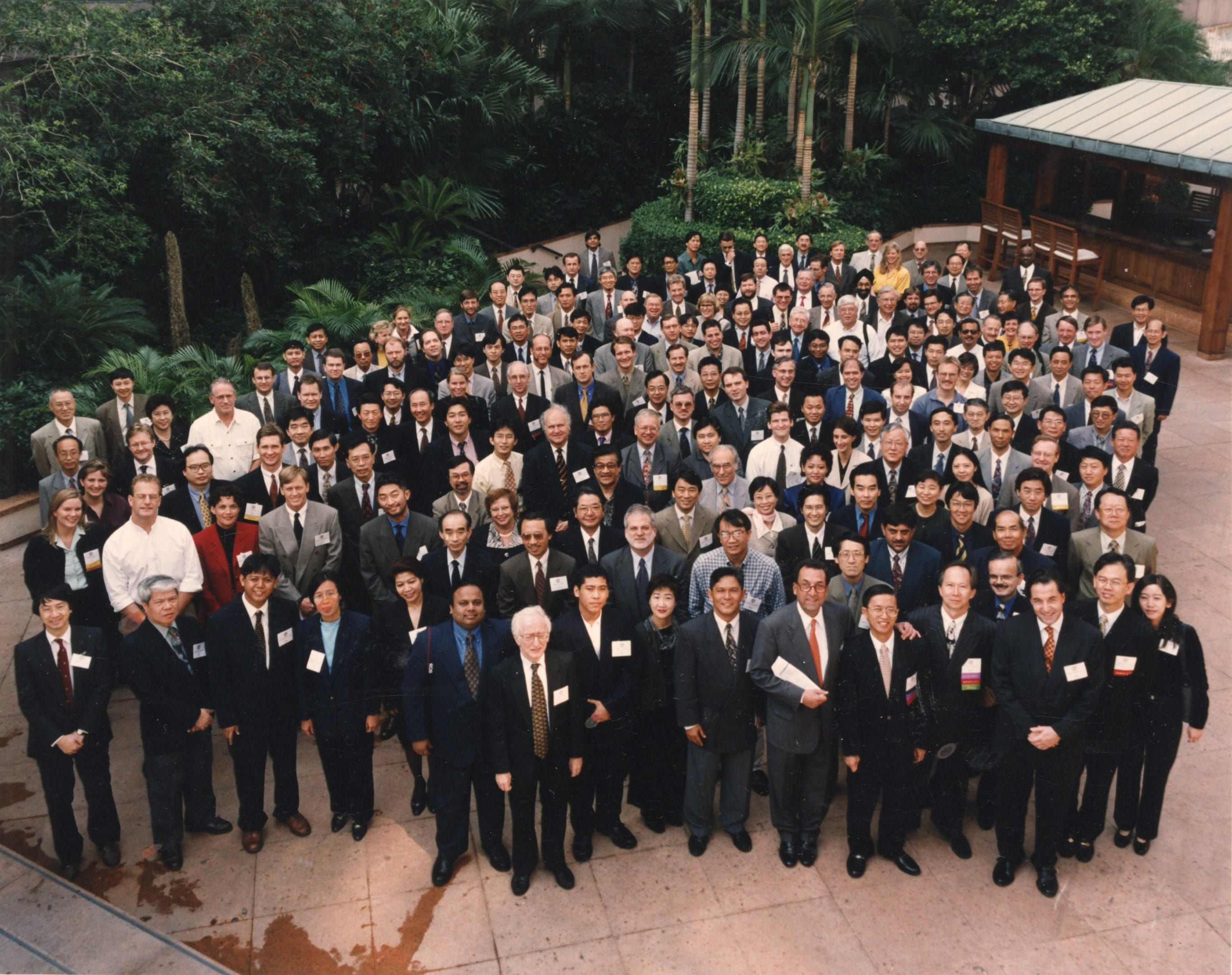
The exclusive society had grown, each event attracting some 800 participants. It was becoming a powerful magnet to attract new interest in Gamma Knife and radiosurgery as a method. The last meeting was held in Dubai in 2018. By then, the meetings had played their most important role. According to Danny Leksell: “Now this method is so ingrained in the daily neurosurgical activities, and so incredibly well-publicized in thousands of scientific works that can be found online, so I felt that it was time to close this meeting.” Although the physical meetings have ceased, the society is still a dynamic community, and its webpage with statistics and support functions remains a powerful tool.
A broadening scope
While Elekta was expanding in Asian markets in the early 1990s, the company also strived to develop a portfolio of other neurosurgical products, beside Gamma Knife and the stereotactic instrument. For this reason, Larry decided to make a number of acquisitions. One was the British Surgical Technical Group Ltd (STG), which produced surgical instruments and specialized in cryosurgery, using extreme cold to destroy diseased tissue. With this acquisition, Elekta could launch a new product, the Leksell Selector, for removal of tissue in connection to neurosurgery. In 1990, Elekta bought Ruggles Instruments in Boston, another instrument producer specialized in brain and spine surgery. The following year, Elekta bought a 47.5 % share hold of its long-term collaborator Motala Verkstad, to secure production when the parent company of Motala went bankrupt.
A field with direct relevance for the Elekta portfolio was the ongoing development of quality brain and body imaging. The underlying need was easy to understand: If surgeons didn’t open up the patient, they needed some other way to “look inside” the patient, so they knew where to direct the treatment. Lars Leksell and others had already used computed tomography (CT) in the late 1970s, but a new generation of image guided surgery was now emerging. The early 1990s saw the breakthrough of magnetic resonance imaging (MRI). These imaging tools were essential to further develop radiosurgery in general and Gamma Knife in particular. With improved resolution, quality and reliability, tumors and irregularities could be detected before disease processes became far advanced, making early treatment possible.
An ambitious development program focused on imaging began in the early 1990s. This, in turn, led to partnerships with companies specialized within the field. One was the Canadian company ISG Technologies, which added a hand-held surgical pointer, the Viewing Wand, to the Elekta portfolio. Another was the French company Deemed, which designed ceiling-mounted robotic microscopes. The research into image guidance technologies was a long-term work, which was expensive and demanded new competence. It was clear that the field was immensely important for the future. The commercial decision for Elekta, however, was whether to develop this on their own or through acquisitions, or whether to partner with firms specializing in visualization solutions. For now, the company decided to have a go at it on their own. It was decidedly too crucial to outsource.
And there were other trends and business opportunities that the company also had to monitor. For instance, why should they limit their business to technologies for brain surgery, why not offer treatment for the whole body? Through technological development, not least concerning digital image guidance, the dividing line between radiotherapy and radiosurgery had become less distinct. To enter the market for radiotherapy was tempting, but it would require great effort and considerable funding. It would also signify a departure from the direction in which the company had moved since Lars Leksell’s days—and maybe change the identity of the company as such. Was Elekta ready to take that step? Considering the situation in the early 1990s, the answer was no. At least not yet.
Regardless of how Elekta decided to go strategically, it would require additional funding. The pace of technological development and international competition alone called for more finances. To fund the road ahead, Elekta invited Scandinavian, American, and British investors in two financing rounds, one in 1989 and another in 1992. In exchange, Elekta assured the investors that the company would generate profit in proportion to their investment. This could be done in two ways: the company could make a public offering in the near future or be eligible for an industrial buy-out.
Either way, by the early 1990s, Elekta was approaching a crossroads where some strategic decisions would have to be made.
Did you find it interesting?
Feel free to share it across social media!

